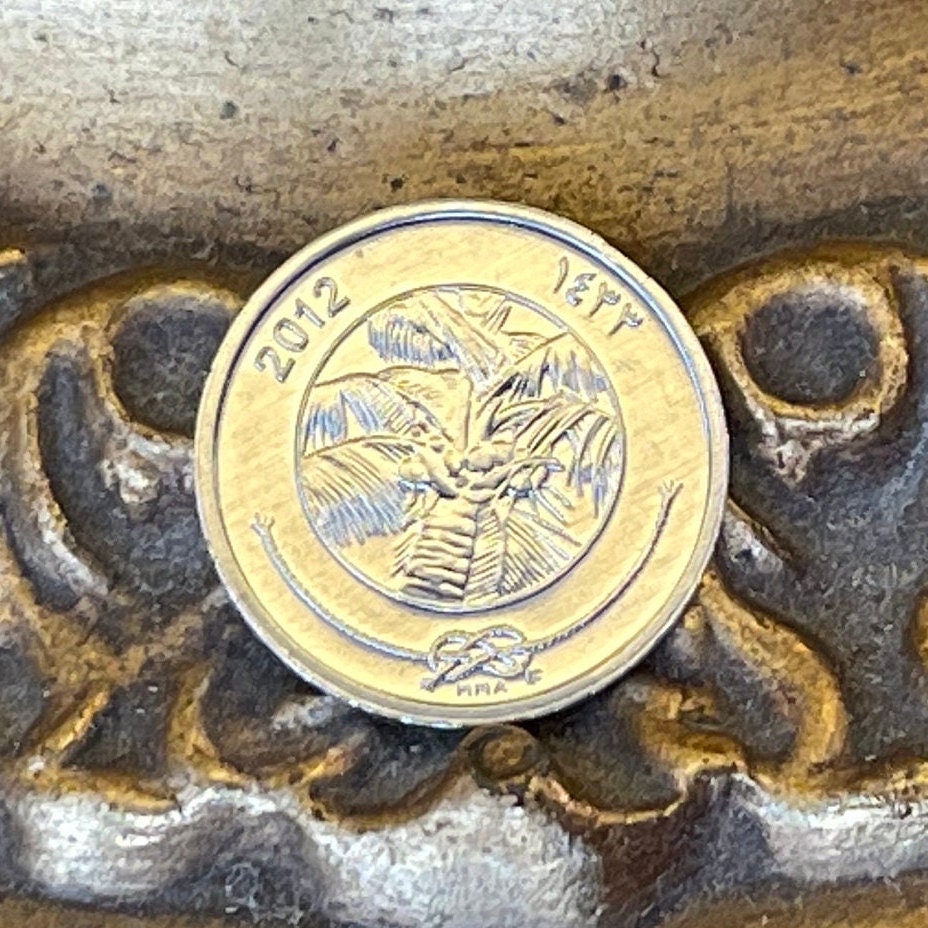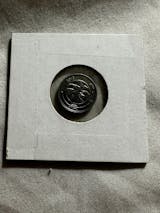elemintalshop
Coconut Palm 1 Laari Maldives Authentic Coin Money for Jewelry and Craft Making (Tropical Islands)
Coconut Palm 1 Laari Maldives Authentic Coin Money for Jewelry and Craft Making (Tropical Islands)
Couldn't load pickup availability
Coconut Palm 1 Laari Maldives Authentic Coin Money for Jewelry and Craft Making (Tropical Islands)
Commemorative issue: FAO
Reverse: Coconut Palm Tree: National tree of the Maldives.
Obverse Lettering: MALDIVES
1 LAARI
Features
Issuer Maldives
Period Second Republic (1968-date)
Type Circulating commemorative coin
Years 1404-1433 (1984-2012)
Calendar Islamic (Hijri)
Value 1 Laari
0.01 MVR = 0.00065 USD
Currency Rufiyaa (1947-date)
Composition Aluminium
Weight 0.46 g
Diameter 15 mm
Thickness 1.2 mm
Shape Round
Orientation Medal alignment ↑↑
Number N# 4751
References KM# 68, Schön# 29
OTHER USES OF THE PALM TREE AND COCONUTS
Published on June 23, 2020
The coconut palm is perhaps known best for the coconut fruits it bears, but has a variety of other uses. It has to be noted that in modern society, the use of the tree has been replaced by modern development. For example: the stem of the tree was traditionally used in boat building, but now it is commonly replaced by fiberglass. Nevertheless, on local islands most of the old practices are still in place and listed below.
HUSK
From the husk of the coconut fruit, coconut fiber (coir) can be extracted. Coir can be used in products such as floor mats, doormats and mattresses. More so, it is used in the Maldives to make rope for decoration and is traditionally used for the production of fishing nets.
The shell can be used for decorative purposes as well. Local shops on Dhigurah have some painted dried coconut husks as well as carved out decorations.
Lastly, after grating a Kaashi, the shells are often dried (on local islands such as Dhigurah) to later use as charcoal to grill the catch of the day.
STEM
Though it is not common practice in the Maldives, from the stem a starch can be extracted and made into flour. As mentioned before, the palm wood used to be the foundation of boatbuilding in the Maldives. These days it is mostly used by local carpenters for furniture and carved into ornamentals.
LEAVES
Every Saturday the local women on Dhigurah collectively head out in search of fallen palm leaves. Apart from tidying up the island, the palm leaves are used! The collected goods are equally divided by the search party, after which they are made into decorative thatching and/or mats. These mats are used locally on sheds, bought by guest houses for decorative purposes or nearby resorts for the same reason.
Furthermore, ekels (hard ‘straws’) can be extracted from the palm leaves. After drying these straws, they can be bound together and serve as a broom. An ekel broom is locally known as an ‘Iloshi fathi’.
ROOT
The root can be used as a dye. Additionally, the root and the coconut have also been used in traditional medicine.
SYMBOL
The coconut has become an integral part of Maldivian life, and is regarded as the national tree of the Maldives. Apart from seeing a real life coconut palm around every corner, they can also be found on the national emblem, the 10 Rufiyaa bank note, and in many images in souvenir shops.
Source: https://www.bliss.mv/en/2020/06/other-uses-of-the-palm-tree-and-coconuts/
Wikipedia:
The coconut tree (Cocos nucifera) is a member of the palm tree family (Arecaceae) and the only living species of the genus Cocos. The term "coconut" (or the archaic "cocoanut") can refer to the whole coconut palm, the seed, or the fruit, which botanically is a drupe, not a nut. The name comes from the old Portuguese word coco, meaning "head" or "skull", after the three indentations on the coconut shell that resemble facial features. They are ubiquitous in coastal tropical regions and are a cultural icon of the tropics.
It is one of the most useful trees in the world and is often referred to as the "tree of life". It provides food, fuel, cosmetics, folk medicine and building materials, among many other uses. The inner flesh of the mature seed, as well as the coconut milk extracted from it, form a regular part of the diets of many people in the tropics and subtropics. Coconuts are distinct from other fruits because their endosperm contains a large quantity of clear liquid, called coconut water or coconut juice. Mature, ripe coconuts can be used as edible seeds, or processed for oil and plant milk from the flesh, charcoal from the hard shell, and coir from the fibrous husk. Dried coconut flesh is called copra, and the oil and milk derived from it are commonly used in cooking – frying in particular – as well as in soaps and cosmetics. Sweet coconut sap can be made into drinks or fermented into palm wine or coconut vinegar. The hard shells, fibrous husks and long pinnate leaves can be used as material to make a variety of products for furnishing and decoration.
The coconut has cultural and religious significance in certain societies, particularly in the Western Pacific Austronesian cultures where it features in the mythologies, songs, and oral traditions. It also had ceremonial importance in pre-colonial animistic religions. It has also acquired religious significance in South Asian cultures, where it is used in Hindu rituals. It forms the basis of wedding and worship rituals in Hinduism. It also plays a central role in the Coconut Religion of Vietnam. The falling nature of their mature fruit has led to preoccupation with death by coconut.
Coconuts were first domesticated by the Austronesian peoples in Island Southeast Asia and were spread during the Neolithic via their seaborne migrations as far east as the Pacific Islands, and as far west as Madagascar and the Comoros. They played a critical role in the long sea voyages of Austronesians by providing a portable source of food and water, as well as providing building materials for Austronesian outrigger boats. Coconuts were also later spread in historic times along the coasts of the Indian and Atlantic Oceans by South Asian, Arab, and European sailors. Coconut populations today can still be divided into two based on these separate introductions - the Pacific coconuts and Indo-Atlantic coconuts, respectively. Coconuts were introduced by Europeans to the Americas only during the colonial era in the Columbian exchange, but there is evidence of a possible pre-Columbian introduction of Pacific coconuts to Panama by Austronesian sailors. The evolutionary origin of the coconut is under dispute, with theories stating that it may have evolved in Asia, South America, or on Pacific islands. Trees grow up to 30 m (100 ft) tall and can yield up to 75 fruits per year, though fewer than 30 is more typical. Plants are intolerant of cold weather and prefer copious precipitation, as well as full sunlight. Many insect pests and diseases affect the species and are a nuisance for commercial production. About 75% of the world's supply of coconuts is produced by Indonesia, the Philippines, and India combined.
Share










Nice coin to add to my collection.
Coins as shown. Perfect condition.
Great coin! Arrived fast and in the condition described. I would recommend ordering from this seller as everything always arrives in great condition!
Tropical and fun for any coin collector 👍👍










